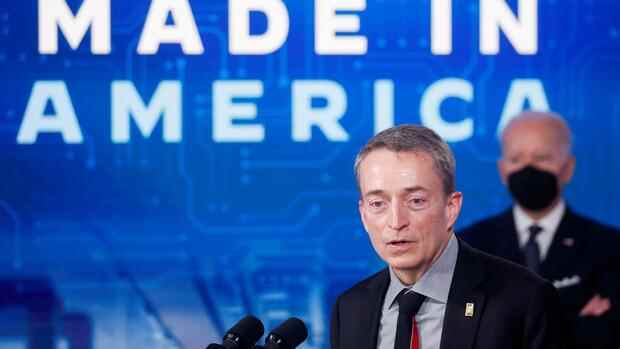The Intel boss is investing billions in new plants – most recently in Ohio. This pleases US President Joe Biden, but the analysts are critical of the high expenditure.
(Photo: Reuters)
Munich There is enough reason to celebrate in the chip industry: there is hardly a group that has not increased sales by at least a quarter in the past year. Only at Intel, the long-standing industry leader, is business sluggish.
Almost exactly a year ago, Pat Gelsinger took over as the new CEO to rebuild the former icon of the semiconductor industry. The latest figures show that it will be a tough and, above all, very expensive race to catch up.
Gelsinger is investing billions of dollars to build more competitive plants. Analysts have known that for a long time. However, the bankers had not expected that the new buildings would devour so much money so quickly. Gelsinger announced on Wednesday evening that earnings in the current quarter would be just 80 cents per share, six cents less than Wall Street experts had predicted.
The share price promptly turned negative in pre-market trading on Thursday. So far, Intel has been one of the very few chip stocks to post a gain this year. There’s a reason investors are so thin-skinned when it comes to the profitability of the Silicon Valley company: Intel was the chip industry’s profit machine for more than two decades.
Top jobs of the day
Find the best jobs now and
be notified by email.
TSMC has left Intel behind
In recent years, however, the contract manufacturer TSMC has technically passed Intel. The most important competitors get their chips from the Taiwanese, above all AMD and Nvidia. Rivals grew big in 2021, while Intel had to settle for a 1% increase in revenue. The profit has even shrunk slightly compared to the previous year.
>>Also read: In the boom in the chip industry, Samsung is overtaking the market leader Intel
With huge investments, Gelsinger is now setting out to overtake TSMC again. Just last week he announced plans to build two $20 billion factories in Ohio. In the long term, plants could even be worth $100 billion in the American Midwest.
Although the Stanford graduate has only been CEO for a year, he knows Intel very well. He worked for the company for 30 years before leaving Intel in 2009. He first moved to EMC, from 2012 he managed VMware, a software provider. At the beginning of 2021, the board of directors finally decided in dire need to bring Gelsinger back.
Internally, it was very well received, say the employees. In conversations with Intel employees, there is often talk of a spirit of optimism. Given his roots in the country, Gelsinger describes himself as a “farm boy”, calls himself a “proud grandfather” and, as a devout Christian, tweets a verse from the Bible every Sunday.
Investors are looking at the profit
Gelsinger also appears in public much more frequently than his predecessors. Just last week he performed with US President Joe Biden. Both share the desire to promote the American chip industry with a lot of money and thus make it more competitive. However, Parliament has so far blocked the plans.
The 60-year-old from Gelsingen traveled to numerous European capitals several times to advertise for Intel to settle in Europe. “We need support from the member states and the EU,” said Gelsinger last year. “We can’t do it alone.” Because in Asia, the chip manufacturers would be attracted with lavish aid.
Originally, the American wanted to announce the locations for his investments in Europe at the end of 2021. Nothing came of it. Apparently the manager underestimated the thicket of different interests and competences in the EU. Gelsinger wants to build plants in Europe for around 100 billion dollars over a decade. For this he demands about 40 billion dollars in subsidies.
Investors, on the other hand, are primarily interested in when Intel will be as profitable again as it was in the good old days, when the processor specialist still unchallengedly dominated the industry. Gelsinger spoke on Wednesday of five years until Intel is back to the previous level.
This long period of time is not surprising. It takes at least three years for a new chip factory to be up and running. And Gelsinger has not even bought the land for the new plants in Europe.
No wonder the boss is asking for patience: “We remain committed to driving long-term, sustainable growth.”
More: Chip supplier ASML: Europe’s most valuable tech group is struggling with the flood of orders
